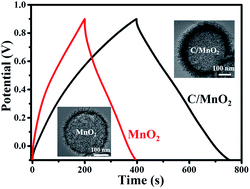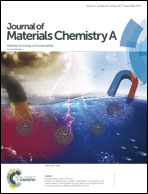Hierarchical porous C/MnO2 composite hollow microspheres with enhanced supercapacitor performance†
Abstract
The successful application of supercapacitors in energy conversion and storage hinges on the development of highly efficient and stable electrode materials. Herein, a composite of manganese oxide (MnO2) and N-doped hollow carbon spheres (NHCSs) was fabricated by a facile two-step process for supercapacitor electrodes. The MnO2–NHCS composite had a NHCS core and a shell composed of hierarchical birnessite-type MnO2 nanoflakes. The NHCSs in the composite serve not only as the template for the growth of MnO2 nanoflakes, but also as the electrically conductive channel for electrochemical performance enhancement. The physicochemical and electrochemical properties of the MnO2–NHCS composite were significantly enhanced as compared with those of MnO2 hollow spheres (MnO2 HSs). The asymmetric supercapacitors (ASCs) assembled with MnO2–NHCS anodes and NHCS cathodes exhibited a high energy density of 26.8 W h kg−1 at a power density of 233 W kg−1, which is superior to those of the ASCs assembled with MnO2 HS anodes and NHCS cathodes (13.5 W h kg−1 at 229 W kg−1). The MnO2–NHCS ASCs also show superior cycling stability for 4000 cycles. The enhanced electrochemical performance of the MnO2–NHCSs makes them a promising electrode material for application in supercapacitors and potentially other energy storage devices.



 Please wait while we load your content...
Please wait while we load your content...